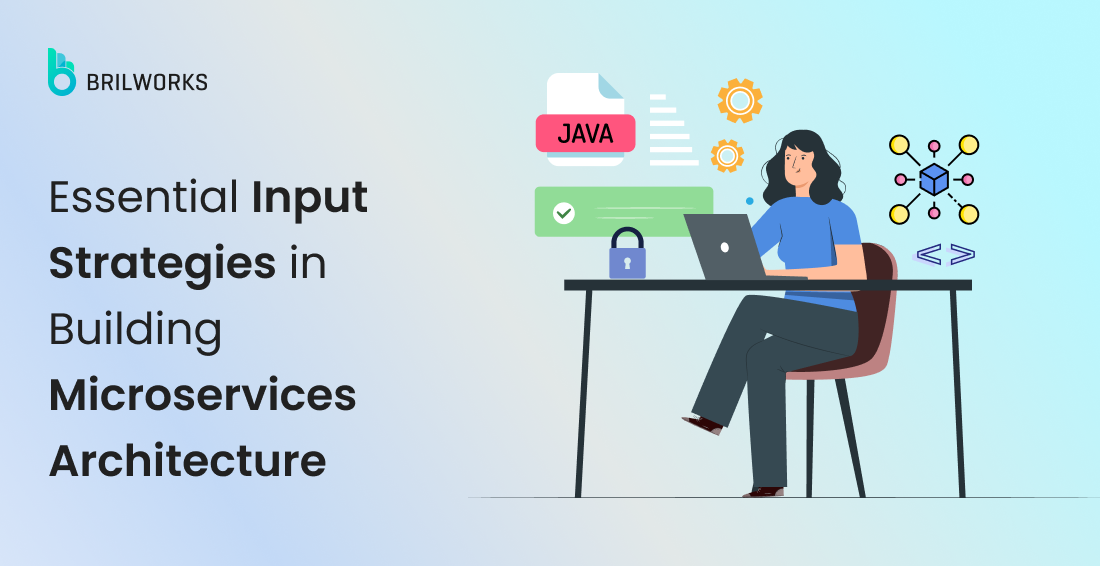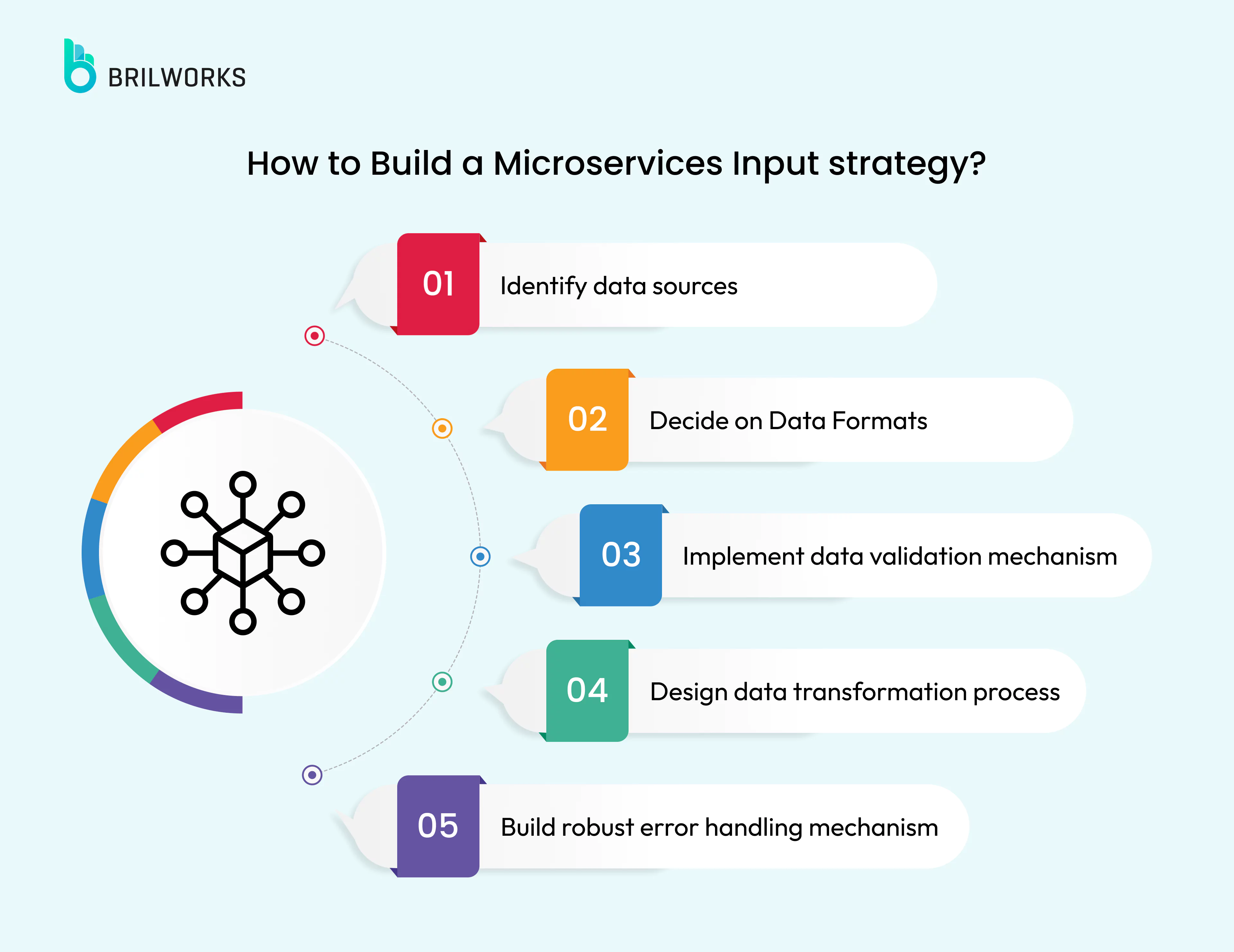COOPERATION MODEL
ARTIFICIAL INTELLIGENCE
PRODUCT ENGINEERING
DevOps & Cloud
LOW-CODE/NO-CODE DEVELOPMENT
INDUSTRY
FRONTEND DEVELOPMENT
CLOUD DEVELOPMENT
MOBILE APP DEVELOPMENT
LOW CODE/ NO CODE DEVELOPMENT
EMERGING TECHNOLOGIES








Nowadays, building scalable and efficient software solutions is more important than ever because of the fast pace of today's digital world. Among those popular design patterns is microservices architecture, which allows developers to break down complex applications into smaller, manageable services. The most important aspect of building effective microservices is understanding and implementing essential input strategies. In this article, we will explore how to build microservices input strategies, including input sensors and input bots, to enhance performance and reliability in your applications.
Before getting into input strategies, you should properly understand what microservices mean. Basically, they are a collection of small, independent services that work together to build an entire system. Each service is responsible for a particular function and can be developed, deployed, and scaled independently. This flexibility is what makes it one of the most popular software architectures today. It offers benefits such as scalability, flexibility, and easy maintenance.
Microservices are essentially a way of designing software applications as suites of independently deployable services. Each service is scoped to a business capability and can be developed by a small team. The modular approach gives better control over deployments and updates. These services talk to each other over lightweight HTTP/REST protocols. They are widely used protocols, therefore, these services can connect to different services, making them more versatile.
If we talk about microservices architecture, they operate on a decentralized governance model. In this way, you build different services using different technologies and tools. If you are building a product, you can involve experts from different backgrounds to build a top-notch service.
They operate on a decentralized governance model. It allows developers to use latest technologies (such as programming language) and tools as per their choice.
The very design encourages the existing development teams to take charge and ownership of their work. As services are packaged within teams, those teams can release systems within short timeframes, release more often, and play around even when the entire system does not need or warrant any changes.
One of the primary benefits that microservices architecture provides is the enhanced scalability. It is possible to increase the capacity for each service individually without having to scale the entire application. This is commendable especially for applications whose different constituent parts have different levels of demand.
They also enhance fault tolerance. The failure of some service will not mean the failure of the whole application. This contains the spread of the damages, and hence enhances the reliability and the continuous working of the system.
Microservices also facilitate continuous delivery and deployment. In this case, a new feature and any updates can be released by teams more often; this in turn helps to make the product reach the market quicker and also makes it easy to address the needs of the users quickly.
Although microservices have benefits, they come with some significant drawbacks. The complexity of handling distributed systems is the biggest problem. Unsuitable communication structures may lead to bottlenecks between services.
Another challenge is data consistency across services. There must be proper strategies for data synchronization and eventual consistency to ensure that all services have the latest information.
Security is another concern with microservices, here, each service needs to secured individually. Sometimes, it is not easy to follow the same guidelines when working individually on different services.
Input strategies are essential for the successful implementation of microservices. They outline the ways in which input enters the system and how communications between services take place. An effective input strategy is in which data travels through the less complicated way and hence improves performance and reliability. Concentrating on input strategies will enable the developers to reduce obstruction problems, work on less latency and overall improve the usability of the applications.
Maintaining high performance in microservices architectures requires efficient data flow. Different strategies for input dictate how data enters the system and how it will be propagated across various services; proper management of the flow, therefore, prevents overload and ensures each service functions optimally.
The other strategies involved in data flow determine how fast a service can respond to requests; developers will optimize input process, reduce latency for faster user experience, which is crucial for applications requiring real-time processing of data.
In addition to this, streamlined data flow allows for optimum resource allocation. Systems can accurately predict load with patterns in the data and give resources with more efficiency, hence saving costs and improving performance.
Bottlenecks are very common in microservices architectures because of the inefficient strategies followed by input. So, identifying and fixing bottlenecks is highly crucial for maintaining system performance. Input strategies should be placed so that load is distributed as evenly as possible on services.
Load balancing is one of the techniques critical for reducing bottlenecks. It spreads incoming data and does not let any single service become overwhelmed, thus optimizing on both performance and reliability.
Another way to achieve it is asynchronous processing. If data capture can be decoupled from processing, then services do not necessarily have to wait, thus the chance of bottlenecks is minimized. This strategy works best in high-traffic scenarios.
The overall aim of good input strategies is, here, to make the user interface as usable as possible. Smoothing out data processing to happen as fast and accurately as possible leads to a smooth interface while using microservices, which eventually terminates at higher user satisfaction and retention.
Input strategies add up to system reliability directly addressed in user experience. The data loss prevention and performance enable the users to trust that the application works correctly.
For example, optimized input processes enable more individualized interaction with users. Drawing from well-controlled user data properly, services can offer relevant experiences that increase engagement and loyalty from end users.
When building microservices input strategies, it's essential to consider the following factors:

Identify the data sources your microservices will interact with. This can include databases, APIs, user inputs, and the like. Knowing these will assist you to develop effective input strategies.
Sources of data can be internal, in the company databases, or external, like APIs from third parties. Every source is unique in its characteristic and requires different techniques in capturing and processing data.
In addition, input sources are changing over time. The strategies for inputting must be flexible enough to accept the new sources and adapt to changes of existing ones. This will ensure a continued smooth flow of data.
Decide on the data formats your services will accept and process. Data formats are: JSON, XML, Protocol Buffers. Choose a format suitable for your application requirements and support efficient serialization as well as deserialization of data.
Data formats impact the speed and efficiency of data processing. JSON is widely used for its simplicity and readability. Protocol Buffers offer a more efficient serialization that is better suited for applications with high performance requirements.
The data format also determines interoperability. Selecting a common format ensures compatibility between differing services and systems, therefore assuring an easy exchange and integration of data.
Implement validation checks for incoming data to make sure it's correct and consistent. This ensures integrity of the data as well as preventing it from reaching your application in error.
Data validation can occur at multiple stages, including at the input source and within individual services. By validating data early, developers can prevent the propagation of errors throughout the system.
Data validation also contributes to system security because services screen incoming data for anomalies or malicious content, thereby helping prevent possible threats and ultimately improving security in general.
Whether the data transformation should occur before it is passed to the microservices or not, is another consideration. In data transformation cleaning, aggregation, and normalization are some of the general operations performed for the specific needs of each service.
Data transformation ensures that services can receive data in the required format. It, therefore, reduces the processing time and increases efficiency especially for services whose data format is stringent.
Transformation processes ought to be designed with efficiency and scalability in mind. Developers can process big data using modern data processing frameworks and handle gigantic volumes of data without losing performance.
Design robust error handling mechanisms addressing potential issues which may crop up during data processing. This includes invalid data, network failures, and other exceptions that could affect the performance of your microservices.
Error handling must proactively identify potential problems before they become problems. Automated alerts and logging will allow the developers to respond rapidly and manage problems effectively.
Further, error handling strategies should incorporate fallbacks, ensuring that services can keep on working despite problems. That makes them resilient as well, which is indispensable to ensure uptime and reliability.
Input sensors are software components that read data from their sources, such as user interactions, system events, or APIs from external systems. Building input sensors for microservices requires the following strategies.
Implement an event-driven architecture where the input sensors are listening for events that will trigger appropriate actions. This would ensure that microservices react in real-time to changes in the system or on user interactions.
Event-driven architectures enable services to react promptly toward new information, thus improving response. This is particularly beneficial for applications with dynamic data or real-time requirements.
Further, event-driven systems are inherently scalable. As data volume increases, the system can accommodate more events without degrading performance, thus ensuring consistent user experience.
Output data should be processed asynchronously in order to handle input data efficiently. Thereby, it decouples capturing data from processing logic such that services might continue operating while still waiting for fully processed input data.
Asynchronous processing reduces latency and improves throughput by enabling services to process multiple data inputs concurrently. This approach is well-suited to applications with big data volumes or bursty traffic patterns.
Asynchronous systems are also more resistant to failures than their synchronous counterparts. Because queued data is processed separately, services can more easily recover from disruptions and guarantee reliability.
It is then possible to capture large volumes of data in real-time by using data streaming technologies such as Apache Kafka or Amazon Kinesis. Streaming data enables microservices to handle high-throughput workloads and reduce latency.
Continuous data flows may be efficiently managed by streaming technologies to enable services to process data as they arrive. This is very useful for applications that are needed to analyze or act on the data real-time.
Streaming platforms also provide inbuilt functionalities, such as data partitioning and replication, which add further scalability and fault tolerance. Such systems can scale according to the needs of the applications.
Implement load balancing strategies to ensure distribution of input data among microservices. This helps prevent overloading a single service and ensures optimal performance.
Load balancing is essential for maintaining system stability, especially in environments with fluctuating data loads. By distributing data evenly, services can operate efficiently without bottlenecks.
Dynamic scaling and traffic shaping are some of the more advanced load balancing techniques to improve system performance. Real-time adjustments can be made based on current demand for optimal resource utilization.
The performance of input sensors must be monitored and logged with mechanisms for their setup. This will enable the developers to trace bottlenecks, troubleshoot problems, and optimize the capture processes themselves.
The comprehensive monitoring provides insight into system health and performance with proactive maintenance. Potential issues may be noticed at an early stage, thus preventing larger problems from developing.
Logging will also help in understanding system behavior and debugging. Without logs, developers cannot trace the data flow and pinpoint sources of errors, thus leading to longer solution time and optimization time.
Input bots are automated agents interacting with microservices to perform certain functionalities, be it data input, processing, or monitoring of activities. Some strategies in building input bots for microservices include the following:
Identify the repetitive tasks that could be automated by input bots. Such tasks may include data entry, form submissions, or repetitive system checks. The above tasks can be automated to enhance the efficiency of the work being performed and reduce human error.
Automation releases human resources to focus on more complex tasks for enhanced productivity. By addressing mundane tasks, bots ensure consistency and accuracy, reducing the chance of errors.
Moreover, automated tasks are typically faster than manual processes, which leads to quicker response times and improved system performance. This speed becomes a crucial criterion for systems that require the timely processing of data.
Use APIs for easy integration between input bots and microservices for smooth interaction. Actually, APIs are standardized interfaces that would allow bots to interact with services consistently.
APIs offer well-defined interfaces for data interaction, simplifying integration and reducing development time. By using APIs, bots can access services efficiently, improving overall system performance.
Moreover, APIs ensure security because they allow access to services in a controlled way. By incorporating authentication and authorization, developers can ensure that bots are interacting with permitted services only.
The authentication and authorization mechanisms are implemented to control access to microservices. Therefore, the input bots are restricted in their access permissions to carry out the required operations without reading sensitive data.
Authentication systems that are robust also verify the identity of bots. This does ensure that only authorized entities can access services. It prevents unauthorized access and potential security breaches.
Finally, Authorization further refines access control such that bots can only execute what they are allowed to. This has the added security of reducing the potential for misuse or data exposure.
Help design your input bots scalable enough to carry the growing loads since your application keeps growing. This can be done through cloud-based solutions or by using containerization technologies like Docker.
Scalable bots can adapt themselves according to changing demands, ensuring consistent performances in growing volumes of data. By using cloud resources, developers can dynamically adjust capacity according to present needs.
Containerization further enhances scalability by providing isolated environments for bots. This isolation ensures that bots can operate independently, improving reliability and flexibility.
Implement mechanisms for error recovery in case of failure-graceful errors. This includes retry mechanisms, failover solutions, and alerting systems to notify developers if there is an issue.
Error recovery ensures that bots can continue operating despite disruptions, maintaining system reliability. By implementing retries, bots can overcome transient errors and ensure task completion.
Failover solutions deliver redundancy since the bot can switch to backup systems in case of a failure. This redundancy is an important catalyst for uptime and consistent service delivery.
In fact, building microservices based on successful input strategies is critical to developing scalable, productive applications. It allows developers to know how to build microservices input, input sensors, and input bots, and to optimize data processing in relation to their application performance. Based on such guidelines - concentrating on data sources, validation, transformation, and error handling, along with event-driven architectures, asynchronous processing, and task automation - ensure the richness of your microservices for adaptation to modern software development's demands.
Remember, the input strategies for successful microservices revolve around continuous monitoring and optimization as well as adaptation to the evolving needs of your application. Follow these best practices by creating a strong and efficient microservices architecture that provides truly wonderful user experiences as well as business needs.
Continuous monitoring is vital for maintaining the health and performance of microservices. By regularly reviewing system metrics, developers can identify trends and potential issues, allowing for proactive improvements.
Adaptation is equally important. As application requirements and user demands evolve, input strategies must be adjusted to meet new challenges. This flexibility ensures that microservices remain effective and responsive.
Committing to continuous monitoring and adaptation helps developers ensure that their microservices architecture keeps delivering value and supports business growth.
Microservices are an architectural style that structures an application as a collection of loosely coupled services, each of which implements business capabilities. They are essential in modern software architecture because they enhance scalability, improve deployment efficiency, and allow for flexible, independent development across different teams.
Input strategies play a crucial role in the effectiveness of a microservices architecture by ensuring that data is efficiently captured, validated, and processed. Effective input strategies help improve system performance, maintain data integrity, and enhance user experience by minimizing errors and optimizing resource usage.
Some best practices include using well-defined APIs for data exchange, implementing robust validation mechanisms at each service boundary, and adopting asynchronous communication techniques to handle input data efficiently. Additionally, ensuring consistent data formats and leveraging cloud-native tools can optimize input processing in microservices.
In microservices, data validation is often decentralized, with each service responsible for validating its own inputs. This contrasts with monolithic architectures, where validation might be centralized. In a microservices setup, validation must be consistent across services to ensure data integrity and reliability throughout the system.
Several tools and frameworks can assist in managing input in microservices, including API gateways like Kong or Zuul for handling input traffic, message brokers like RabbitMQ or Kafka for asynchronous communication, and validation libraries such as Hibernate Validator for ensuring data correctness. These tools help streamline input handling and maintain service reliability.
Get In Touch
Contact us for your software development requirements
Get In Touch
Contact us for your software development requirements